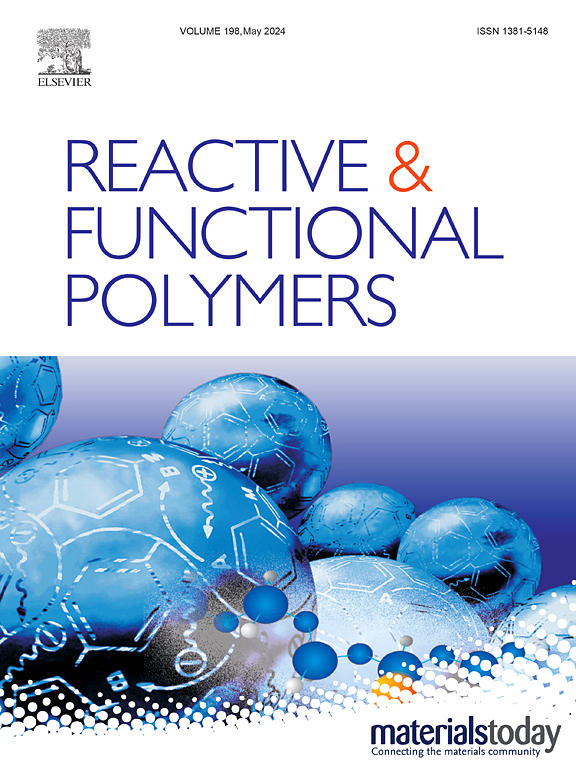Flexible sodium alginate-gelatin hydrogel membrane incorporated with green synthesized bimetallic ZnO:CeO2 nanocomposite for antioxidant, antibacterial and biocompatibility studies
IF 4.5
3区 工程技术
Q1 CHEMISTRY, APPLIED
引用次数: 0
Abstract
In recent years, natural polymers including sodium alginate and gelatin have attained huge attention because of their potential applications in wound healing. In this study, sodium alginate and gelatin (SA-GE) composite hydrogel membranes were incorporated with Moringa oleifera leaf extract mediated green synthesized bimetallic zinc oxide:cerium oxide nanocomposite (ZnO:CeO2 NCs) to improve the antioxidant, antibacterial and biocompatibility of the hydrogel. Furthermore, bimetallic ZnO:CeO2 NCs were incorporated into SA-GE hydrogel membranes with varying concentrations such as 1 % (SA-GE@I), 2.5 % (SA-GE@II) and 5 % (SA-GE@III). The SA-GE hydrogel membranes were fabricated by the Freeze-gelation method. Green synthesized ZnO:CeO2 NCs were characterized by X-ray diffraction, UV visible (UV–vis) spectroscopy, scanning electron microscopy (SEM) and Energy dispersive X-rays (EDX). The prepared SA-GE, SA-GE@I, SA-GE@II and SA-GE@III hydrogel membranes structural analysis was done by SEM, Fourier transform infrared (FTIR), swelling and degradation studies. Universal testing Machine (UTM) was used to evaluate the impact of ZnO:CeO2 NCs on tensile strength, elongation (%) and Young's modulus of SA-GE hydrogel membrane. Furthermore, DPPH assay and disk diffusion methods were followed to evaluate the antioxidant potential and antibacterial activity of SA-GE, SA-GE@I, SA-GE@II and SA-GE@III. Then, the biocompatibility of SA-GE and influence of green synthesized ZnO:CeO2 NCs on SA-GE biocompatibility was evaluated againt NIH-3T3 cell lines by following alamar blue assay.

柔性海藻酸钠-明胶水凝胶膜与绿色合成双金属ZnO:CeO2纳米复合材料的抗氧化、抗菌和生物相容性研究
近年来,海藻酸钠和明胶等天然聚合物因其在伤口愈合中的潜在应用而受到广泛关注。本研究将海藻酸钠-明胶(SA-GE)复合水凝胶膜掺入辣木叶提取物介导的绿色合成的双金属氧化锌:氧化铈纳米复合材料(ZnO:CeO2 NCs),以提高水凝胶的抗氧化、抗菌和生物相容性。此外,将双金属ZnO:CeO2纳米颗粒以1% (SA-GE@I)、2.5% (SA-GE@II)和5% (SA-GE@III)的不同浓度掺入SA-GE水凝胶膜中。采用冷冻凝胶法制备了SA-GE水凝胶膜。采用x射线衍射、紫外可见(UV - vis)光谱、扫描电子显微镜(SEM)和能量色散x射线(EDX)对绿色合成的ZnO:CeO2纳米材料进行了表征。对制备的SA-GE、SA-GE@I、SA-GE@II和SA-GE@III水凝胶膜进行了扫描电镜(SEM)、傅里叶变换红外(FTIR)、溶胀和降解研究。采用万能试验机(UTM)研究了ZnO:CeO2纳米材料对SA-GE水凝胶膜抗拉强度、伸长率(%)和杨氏模量的影响。采用DPPH法和纸片扩散法评价SA-GE、SA-GE@I、SA-GE@II和SA-GE@III的抗氧化能力和抗菌活性。然后,采用alamar蓝法评价了SA-GE的生物相容性以及绿色合成的ZnO:CeO2 NCs对NIH-3T3细胞株生物相容性的影响。
本文章由计算机程序翻译,如有差异,请以英文原文为准。
求助全文
约1分钟内获得全文
求助全文
来源期刊

Reactive & Functional Polymers
工程技术-高分子科学
CiteScore
8.90
自引率
5.90%
发文量
259
审稿时长
27 days
期刊介绍:
Reactive & Functional Polymers provides a forum to disseminate original ideas, concepts and developments in the science and technology of polymers with functional groups, which impart specific chemical reactivity or physical, chemical, structural, biological, and pharmacological functionality. The scope covers organic polymers, acting for instance as reagents, catalysts, templates, ion-exchangers, selective sorbents, chelating or antimicrobial agents, drug carriers, sensors, membranes, and hydrogels. This also includes reactive cross-linkable prepolymers and high-performance thermosetting polymers, natural or degradable polymers, conducting polymers, and porous polymers.
Original research articles must contain thorough molecular and material characterization data on synthesis of the above polymers in combination with their applications. Applications include but are not limited to catalysis, water or effluent treatment, separations and recovery, electronics and information storage, energy conversion, encapsulation, or adhesion.
 求助内容:
求助内容: 应助结果提醒方式:
应助结果提醒方式:


